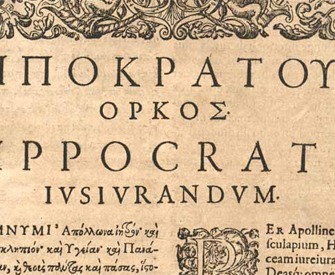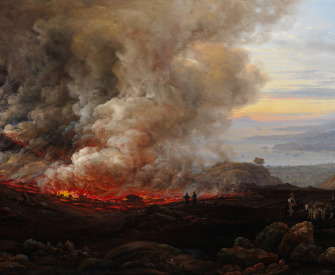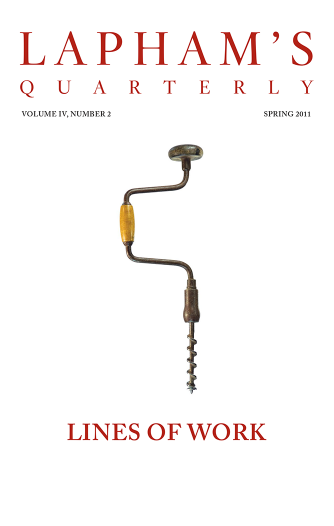If the present be compared with the remote past, it is easily seen that in all cities and in all peoples there are the same desires and the same passions as there always were.
—Niccolò Machiavelli, 1513Necropolis
The corpse has proved to be a bedeviling problem for the city—how do we live with our dead?
By Colin Dickey
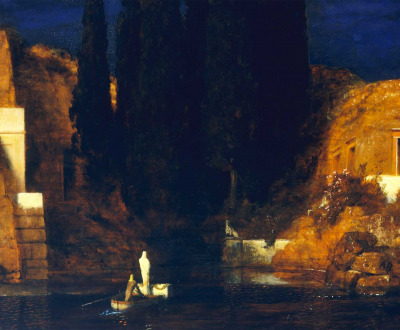
Island of the Dead, by Arnold Böcklin, 1880. The Metropolitan Museum of Art, Reisinger Fund, 1926.
Two thousand years ago, a traveler on his way to Rome would be greeted by its citizens long before reaching the city itself. All along the highways leading into the capital, columned sepulchers, shrunken follies, and walled-in villas lined the streets. Tombs addressed themselves to passersby, like Burma-Shave signs from the beyond:
You are human, stop and contemplate my tomb, young man, in order to know what you will be. I did no wrong. I performed many duties. Live well, for soon this will come to you.
To the spirits of the departed Lucius Annius Octavius Valerianus. I escape. I flee. Goodbye Hope and Fortune. There will be no more prayers from me, so have your sport with others.
These tombs greeted everyone seeking to get to the city—long before reaching the metropolis, one first had to pass through the necropolis, gathered around the edge of the city like a photographic negative of Rome itself.
The corpse has proved one of the most consistently bedeviling problems of the city, ancient and modern. Simultaneously sacred and polluting, the dead cannot simply be disposed of. Attitudes toward death among Romans varied, but some form of proper burial was always extremely important; only the poorest of the poor were buried in the mass graves well outside of town. Even for those who were cremated, some part of the corpse was first removed so at least a token of the body could be buried. Many in Rome joined burial clubs in which members paid dues so as to have their funeral costs covered. Those who could afford it allowed their slaves to be buried in their crypts, which was more than just altruism—offering burial for one’s slaves had the additional benefit of ensuring that others were invested in the upkeep of your tomb.
The Twelve Tables, the ancient law of Rome, specifically prohibited burial inside the pomerium, the symbolic edge of the city defined by its walls. A boundary marker found outside the city made the enforcement clear: “For the public good. No burning of corpses beyond this marker in the direction of the city. No dumping of rubbish or corpses. Take a shit farther on if you want to avoid trouble.”
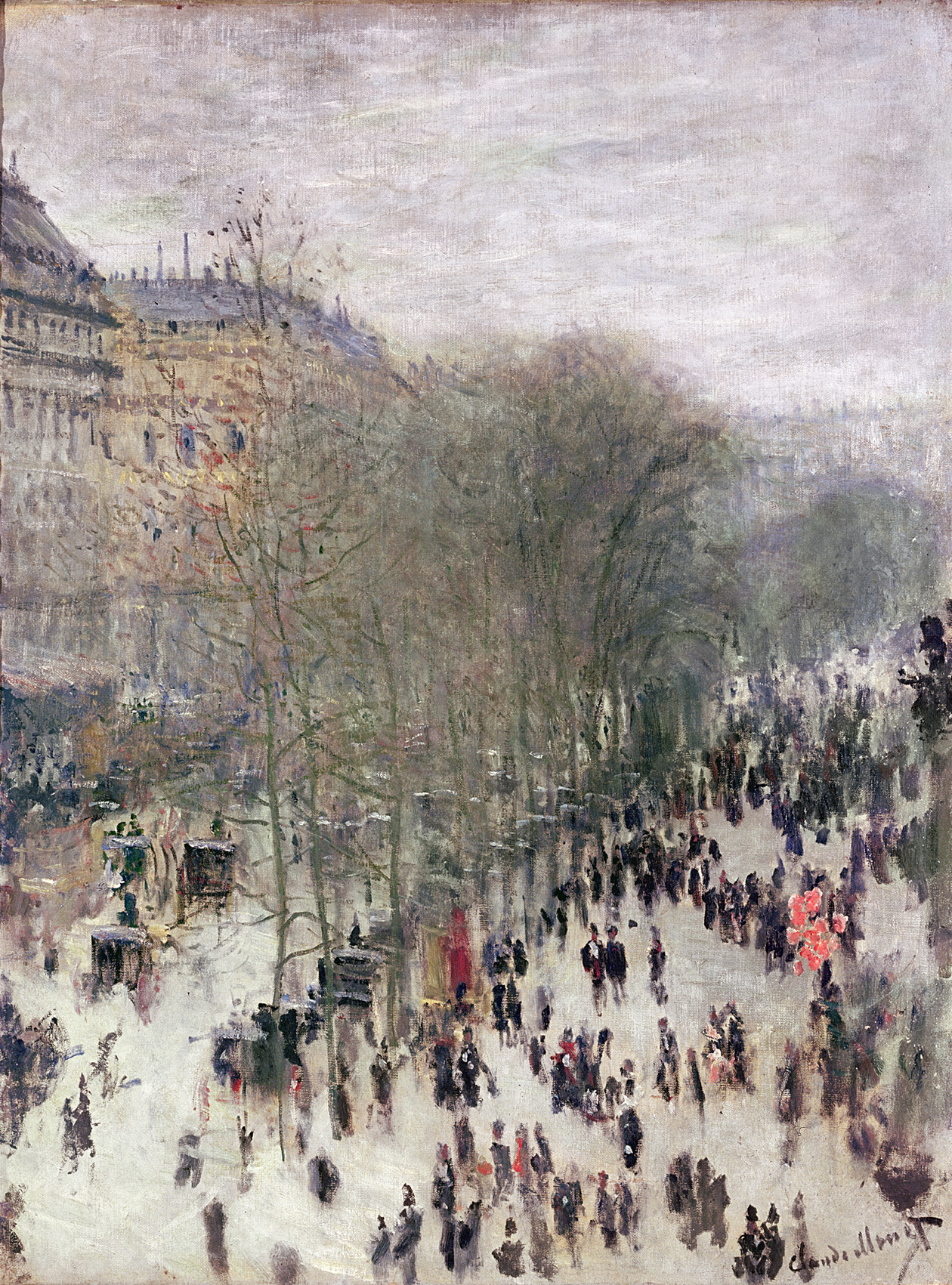
Boulevard des Capucines, by Claude Monet, c. 1873. Nelson-Atkins Museum of Art, Kansas City, Missouri.
Roman law took this prohibition seriously: fines for city burial could run five times the annual salary of a legionary. Exceptions were made for children less than forty days old and for important figures—Caesar fought for and won special dispensation to be buried within the pomerium. If the Romans could not bury their dead inside the city, they nonetheless wanted them close by—the corpse itself may have been polluting, but the grave was not, and families often made pilgrimages to the monuments of loved ones. But in general, contact with the dead body was defiling—so defiling that undertakers, paradoxically, could not be buried in communal cemeteries, having debased themselves in life by accepting money for working with death.
This attitude toward death changed sharply with the introduction of Christianity, which had far-reaching consequences for the topography of the city. Most cultures have venerated their dead heroes, but what made Christianity different was its veneration not just of saints but of their physical bodies. Romans found this aspect of Christianity particularly repugnant and complained of how Christians “collected the bones and skulls of criminals…made them out to be gods, and thought that they became better by defiling themselves at their graves.”
Christians gradually began to change the social function of the cemetery. Romans had always treated tombs as private places for families, not for rituals in which bones were passed between congregants to be fondled and kissed. A place of private reflection had become one of communal celebration, and as the cemetery became a new destination for pilgrims, massive shrines and edifices soon rivaled the cities themselves. This practice began in North African cities like Tébessa in modern-day Algeria, where the bishop Alexander built up the tomb of St. Crispina, complete with a pilgrim’s path 150 meters long flanked by arcades and courtyards. When Paulinus was first installed as bishop in the southern Italian city of Nola around 409, he quickly moved to cement his power through expanding the tomb of the local icon, St. Felix. Felix’s tomb was located well outside the city limits, but Paulinus nonetheless turned it into a vast complex, even ordering the destruction of two huts when their owners refused to move. With its triple archways and wide porticoes, travelers on the way to Nola often confused Felix’s tomb with the city itself.
Alexander and Paulinus were not alone. Throughout early Christendom, bishops consolidated power around the tomb. The cemetery where St. Peter was buried was well outside of Rome’s city walls in a distant plot of land named Vatican Hill. But it was here, not in the city itself, that his followers built his basilica. The religious power base—in Tébessa, Nola, Rome, and elsewhere—had shifted to the periphery, creating an imbalance that could not last. One way or another, the saint would have to come inside the city.
In the French city of Arras, the bishop Vaast asked to be buried outside of the city per the Roman tradition. But upon his death in 540, his body miraculously became so heavy it could not be lifted; when the archpriest asked the corpse if it would rather be carried to the cathedral’s altar, it suddenly became light as a feather. Alternately, if you could not bring the saint to the city, you brought the city to the saint: Pope Leo IV began an expansion of Rome’s walls around 847 to include old St. Peter’s Basilica, and what had once been a peripheral cemetery was now the heart of the Holy Roman Empire.
It was one thing to enshrine the body of the saint in the cathedral, but the Christian city also had to accommodate the worshipful deceased. “The martyrs protect us while we live in our bodies and take care of us after we have left our bodies,” Maximus of Turin explained. “That is why our ancestors took care to place our bodies near the bones of martyrs.” The importance of being buried next to a saint’s relics soon meant that cemeteries were being moved within city walls. The Roman settlement Venta Belgarum in southeastern England established its graveyards four hundred meters outside the city walls, but after it was reconstituted as the city of Winchester in the eighth century, all burials took place on the grounds of the central cathedral. By then the necessity of a Christian burial in consecrated ground was firmly established. Nobility and the clergy were buried inside the church itself, and those who could afford it bought naves or vaults under the church. The graveyard itself was used for commoners; communal pits were left open until their quotas had been filled.
The cemetery attached to the church represented the end of a cycle that began with baptism—one’s life began at the altar and ended only a few feet away. Chateaubriand, remembering his own parish church as a child, described how, “a Christian could not reach the church except by traversing the region of tombstones: it is through death that we arrive in God’s presence.” Burials outside the city came to be seen as utterly backward; a French historian cited in 1598 that for pagans, “It made no difference at all where one buried the dead, whether the land was sacred or profane.”
This wide-open space of land in the heart of the city drew the living just as it drew the dead. Because it was consecrated ground, violence was prohibited, and by the eleventh century, merchants in Brittany were setting up shop in graveyards to avoid being robbed. As an added bonus, transactions conducted within this sacred space were tax free, since the municipal government had no jurisdiction there. In Catalonia, fugitives found safe refuge in the church but were unable to leave without facing arrest, so they set up makeshift living quarters on the permanent resting ground of their ancestors, creating a temporary microcity in the space of the protected graveyard.
The problem with this new urban layout, as always, was space. A Roman cemetery could stretch indefinitely into the wilderness, but an intramural churchyard had a limited area and an ever-growing list of residents. By the late medieval period, churches were regularly recycling cemetery space, removing bones to specially designated storerooms, the charnel houses. In England one could buy secondhand furniture from scavenged remains of coffins, appropriately called “coffin furniture.”
Cities with extensive non-Christian populations developed religious laws that alleviated, or at least diverted, the problem of land use. In Indian cities, some of the most populous in the world, Hindu practice has long mandated cremation—instead of cemeteries, rows of pyres line rivers, the Nigambodh Ghat in New Dehli burning dozens of corpses a day. The Ganges, which collects these ashes, acts as a river necropolis, one larger than any made by human hands. Jewish law prohibits the removal of bodies, so when space ran out in the block-long graveyard of the Old Jewish Cemetery in Prague, layers were added—twelve in all—to provide space for the estimated 100,000 inhabitants. Because the tombstones also had to remain intact, each new layer required uprooting the tombstones and replanting them on the new soil, so that the graveyard is now crammed with twelve thousand visible tombstones only inches apart, jutting out at all angles.
Overcrowding plagued most modern cities, but nowhere was this situation worse than in nineteenth-century Paris. By the eighteenth century, the city’s charnel houses had long since run out of space from constant retrenching—at one church, bones were stored above its rafters and arches, nearly to the point of bursting. The churches that stacked the dead on top of one another hardly fared better: in 1763 a report called attention to Parisian cemeteries whose ground was higher than the surrounding buildings. Heavy rains, the report noted, could lead to dangerous and noisome runoff.
The importance of a sacred burial had been so thoroughly corrupted in overcrowded cities by the increasing pressures of urbanization that it led to an impossible situation for public health. The idea of the poisonous miasma—“bad air,” or pollution from dead bodies that could transmit disease—had been around since ancient Greece, but now it took on a new urgency. In 1738 Voltaire argued that the “odious and ridiculous custom of paving the churches with dead bodies every year occasions at Paris epidemical disease, and all the deceased contribute more or less to infect their country.” Another critic suggested that the incense burned during church services was “more necessary to dissipate the foul odors of the continuous putrefaction taking place under our feet than for the holy service to which it is consecrated.” And then in August of 1744, a story from Montpellier shocked the nation: when a vault was opened to receive a new body, poisonous gasses erupted, knocking the priest unconscious and killing three mourners. In Voltaire’s words, the dead had declared war on the living.

, c. 1850. © The Bridgeman Art Library International.
At the same time, there was equally a war of the living against the dead. Political stagnancy allowed graveyards to fall into disrepair, and burial reformers complained of handbills and advertisements plastered all over city tombstones, to say nothing of the widespread grave robbing of cadavers for medical schools. And while the graveyard had once been used as a marketplace, in the late eighteenth century the canon of Reims described a long list of abominations found in the Saint-Symphorien cemetery: laundry hung out to dry, wild packs of dogs digging up corpses, public urination, gambling, and “disorders between the sexes” that “scandalized the choirboys.” With the monarchy paralyzed by the growing political crisis, the city governments could do little to solve these problems, and many saw the poor state of burial as just one more sign of the decadence of the old order.
With the Revolution the atheists of the First Republic banned funeral ceremonies altogether, lest they retain the stink of religion. Bodies were instead trucked to the edge of town and dumped naked in empty quarries, with no family in attendance. These were not just enemies of the state—all citizens found equality and fraternity in these cavernous pits. The kind of disregard seen only in cases of plague or genocide was, for the First Republic, standard operating procedure. The actor Brunet spoke for most Parisians when he supposedly said, “God! If I had to be buried like that, I would rather not die at all!”
It took only a few years to understand how deeply flawed this practice was. Commissioned to look into the city’s cemeteries, Jacques Cambry wrote in his 1799 report, “I shall spare your sensibilities the picture I might draw. No other people, no other age, shows man after his death in such a cruel state of abandonment.” As a result, the Minister of the Interior, Lucien Bonaparte, sponsored an essay contest to solicit solutions. The contest asked two questions: “What ceremonies should be performed at funerals?” and “What regulations should be adopted regarding burial?” The winning entry advocated embalming and exhibiting the body after death, to prolong a “communication with the dead.” Government officials replaced priests, but otherwise the plan reinstated much of traditional burial rituals. It did, however, discourage tombs and monuments, preferring discrete inscriptions and grass mounds, and imagining an idyllic, parklike atmosphere where one could mourn and reflect at leisure. Ultimately it was Lucien’s powerful brother who would finally resolve the question of French burial.
Napoleon’s imperial decree of 23 Prairial, year XII [June 12, 1804], codified much of contemporary burial practices, both for Paris and as a model for the modern cemetery in Europe and beyond. Bodies could not be buried on top of one another, and each was guaranteed a plot for all eternity. A coffin was mandatory, and everyone had the right to erect a tombstone over a loved one’s grave. In time, economic realities would curtail some of the universal equality envisioned by Napoleon’s decree. Problems of space obligated the retrenching of graves for those who couldn’t afford to buy plots in perpetuity. Plots were leased for five or ten years, at which point the headstone was removed and the grave reused. In 1806 the state established fixed prices for different levels of funeral service, according to social class, prompting one senator to write excitedly, “Scandalous division into classes of creatures who come before God clothed only in their good and evil deeds!” But the city of the dead has always, and will always, reflect the social divisions of the living world.
It was in the Parisian suburbs that the now familiar contemporary cemetery began to take shape: wide, rolling, undisturbed grassy fields, punctuated by somber crypts and monuments. Opened in 1804 and situated on the former garden estate of Louis XIV’s confessor (from whom it took its name), the massive Père Lachaise, a garden necropolis stretching 118 acres into the hilly suburbs, finally solved Paris’ burial problems. Images of Paris from the heights of the cemetery became increasingly popular, and Balzac’s Père Goriot (1835) ends with its protagonist Rastignac gazing down on the city from Père Lachaise, as though the only way to take in the entire city was from its majestic necropolis.
Other cities soon followed: the Glasgow Necropolis opened in 1832, and a visitor was awed by its rows of “elegant and costly monuments,” calling it “a silent but significant city of the dead.” The first American garden cemetery was Mount Auburn, outside of Boston, which opened the year before, followed by Laurel Hill in Philadelphia in 1836 and New York City’s Green-Wood in 1838. Soon city cemeteries the world over—from Barcelona to Mexico City to Tokyo—were emulating this Arcadian design.
A hick town is one where there is no place to go where you shouldn’t go.
—Alexander Woollcott, 1935The idea of the so-called garden cemetery drew from a heavily romanticized image of the Roman necropolis stretching out into the countryside. Wordsworth, recalling the Roman practice of building tombs along highways, wrote, “Many tender similitudes must these objects have presented to the mind of the traveler leaning upon one of the tombs, or reposing in the coolness of its shade,” as opposed to “the unsightly manner in which our monuments are crowded together in the busy, noisy, unclean, and almost grassless churchyard of a large town.”
But if this was a return to an ancient practice, it also responded to a more modern problem: the disappearance of the wilderness in an age of industrialization. Particularly in the United States, where Americans had been domesticating the wilderness around them for two hundred years, the sudden growth of manufacturing cities like Lowell, Massachusetts, caused a romantic yearning for a nature now vanishing. While Mount Auburn and other American cemeteries were direct imitations of Père Lachaise, they were not repurposed gardens; instead they were carved out of the diminishing wilderness in an effort to preserve natural beauty from what one reformer dubbed “the all-subduing and all-conquering divinity of mechanism,” anticipating the national-parks movement of the following century.
Whenever possible, garden cemeteries were established well outside of town. Père Lachaise was so far from the city that administrators had trouble attracting funerals until they staged a publicity stunt in 1817 to heighten its profile, transferring to it the remains of the lovers Héloïse and Abelard. The massive Brookwood Cemetery was built so far from London (about thirty miles away, in Surrey), that it necessitated the establishment of a dedicated railway line: the Brookwood Necropolis Railway, which opened in 1854 and ferried the dead multiple times each week for ninety years until it was destroyed in the German air raids of 1941.
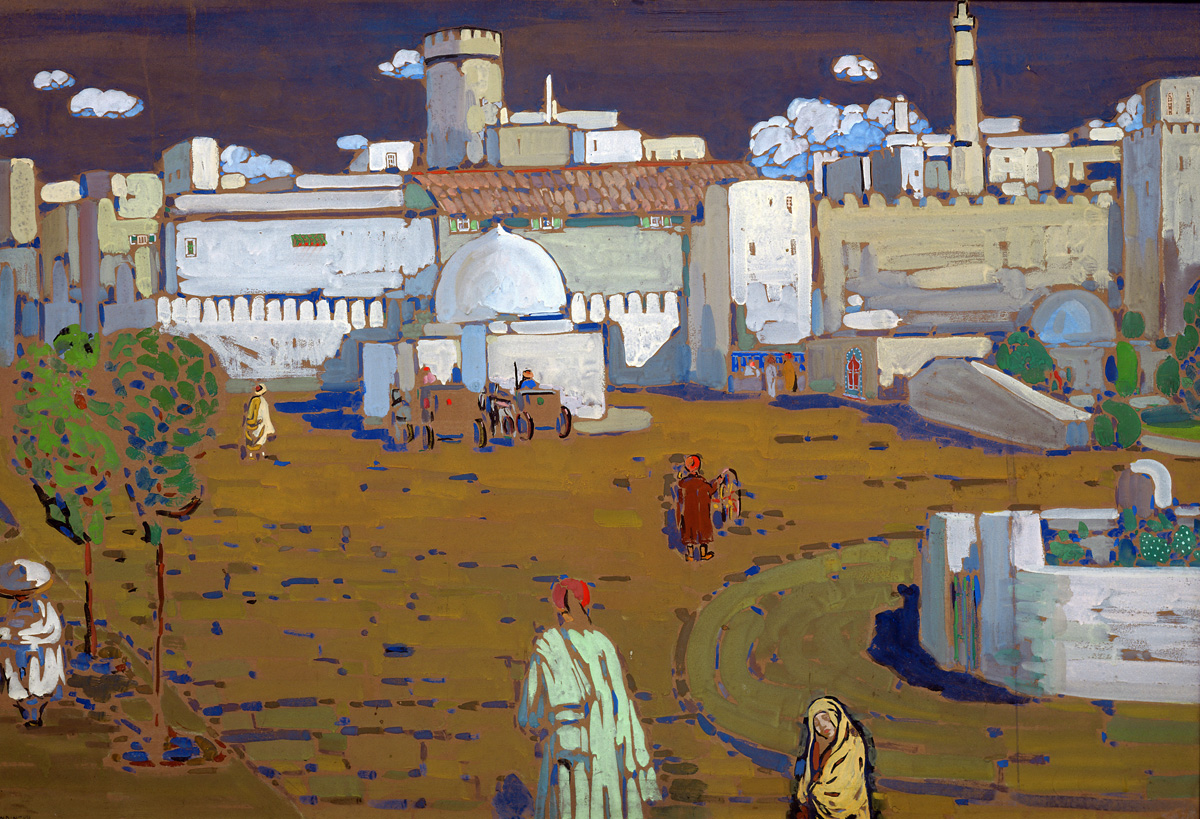
Arab City, by Wassily Kandinsky, 1905. Musée National d’Art Moderne, Centre Georges Pompidou, Paris.
This distance had its symbolic aspect. It was important that the garden cemetery be seen as an antidote to the city. “The burial places for the metropolis ought to be made sufficiently large to serve at the same time as breathing places,” wrote John Claudius Loudon, the garden cemetery’s most ardent champion. Like the Roman cemeteries it hearkened back to, the garden cemetery was imagined as a place of escape for weary city dwellers. In this way it also offered a novel solution to the problem of upkeep. City populations, transient and without deep family roots, could not be relied on to maintain the graves of ancestors, but by providing a space for city dwellers, the cemetery had a natural constituency invested in its continued maintenance. It was not for the dead; it was for the living.
By the dawn of the twentieth century, the garden-cemetery movement proved prohibitively utopian—city land was deemed just too precious to waste on those who couldn’t fully appreciate it. Partly this was due to a resurgence in cremation—the first modern cremation chamber was exhibited in Vienna in 1873. In most cases court battles were needed to establish its legality, but cultural and religious attitudes had no choice but to accommodate themselves to sanitation developments. Pantéon Civil de Dolores in Mexico City has pushed especially hard for cremation among its patrons; having run out of space decades ago, even those with a space already secured have only two options: cremation or burial atop an existing coffin.
But public parks founded in the mid-nineteenth century had come to fulfill the cemetery’s role as a natural respite. Frederick Law Olmsted’s Central Park, opened around 1857, offered a cemetery without the tombs, subtly supplanting the social function of the garden cemetery. When San Francisco expelled its dead in 1900, it did so out of concerns not for sanitation or symbolism but for real estate. San Francisco’s dead found a home in the nearby suburb of Colma, “The City of the Silent,” and while Colma may hold 1.5 million former inhabitants of San Francisco in its seventeen cemeteries (comprising 73 percent of Colma’s land), the necropolis holds little romantic sway over the city’s imagination.
By the mid-twentieth century, it became difficult to imagine that cemeteries had once been used as pleasure grounds, and today’s Western visitors to Tokyo sometimes find it morbid that residents flock to the Aoyama Cemetery to view the cherry blossoms as though it were a park—oblivious to the fact that the Meiji government established Aoyama in 1872 in direct imitation of Western garden cemeteries.
A contemporary visitor to Los Angeles may be unnerved by Forest Lawn’s chain of “memorial parks,” a slick presentation of death excoriated by Jessica Mitford in
The American Way of Death. The absence of tombstones (all headstones are flat for the lawnlike effect, and for ease of lawnmowers), the museums, the gift shops, and the general theme-park atmosphere—it may all seem a bit tacky, but the traditions it disrespects are themselves far more recent than we care to admit, and they have evolved constantly to keep pace with the needs of the modern city.
After all, the necropolis has always had to adapt to the metropolis that it shadows, and it is the cemetery, not the park, that best mirrors the city. In his address consecrating Mount Auburn, Judge Joseph Story spoke of a “solemn calm…as if we were in the bosom of a wilderness, broken only by the breeze as it murmurs through the tops of the forest, or by the notes of the warbler pouring forth his matin or his evening song.” But this tranquility, he reminded his audience, was never far removed from the sprawling city nearby: “Ascend but a few steps, and what a change of scenery to surprise and delight us. We seem, as it were, to pass from the confines of death to the bright and balmy regions of life…In the distance, the city—at once the object of our admiration and our love—rears its proud eminences, its glittering spires, its lofty towers, its graceful mansions, its curling smoke, its crowded haunts of business and pleasure, which speak to the eye, and yet leave a noiseless loneliness on the ear.”
He concluded, “We stand, as it were, upon the borders of two worlds, and as the mood of our minds may be, we may gather lessons of profound wisdom by contrasting the one with the other, or indulge in the dreams of hope and ambition, or solace our hearts by melancholy meditations.” Like the view of Paris from Père Lachaise, this image of the city in the distance, framed by the natural serenity of the cemetery, best represents the symbolic and symbiotic relationship between the two—the bustling, frenetic city of the living, and the silent but significant city of the dead.
